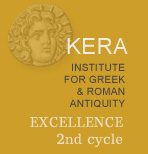Main Site . Other insciptions from the main site of Boubon
23. Honorary inscription for Artemion, a female citizen.
![]()
5 10 |
Βουβωνέω̣ν ἡ̣ β̣ουλὴ̣ κα̣ὶ̣ ὁ δῆ– μος ἐτείμη̣σ̣ε̣ν Ἀρτέμιον Τρωΐλου Ὀρέστου, Β̣ο̣υβωνίδ[α], γυναῖκα εὐγενίδα τάξεως τῶ[ν] πρωτευόντων τῆς πόλε̣ω̣ς̣, πατρὸς καὶ συν͜γε̣νῶν ἀρξ̣[άν]– των τῆς πατρίδος καὶ τοῦ Λυκίων ἔθνους, σώ– φ̣ρονα, φίλανδρον, π[άσ]ῃ [ἀ]– ρ̣ετῇ κεκοσμ ημ έν η ν, ἱερα– σαμ͜έν͜͜ην̣ [τ]ῶν θεῶν Σεβασ– τῶν μετὰ καὶ τοῦ ἀνδρὸς α[ὐ]– τῆς Νεάρχου τρὶς τοῦ Μο̣– λέσεος, Βουβωνέος, καὶ πολλὰ καὶ μεγάλα ἀνα̣λώ̣– σασαν ͜τῇ ͜πατρίδι. |
The council and the people of Boubon honored Artemion, daughter of Troilos, son of Orestes, citizen of Boubon, a woman of noble birth, ranking among the most distinguished in the city, her father and relatives having held the highest offices both in the city and in the Lycian league, a prudent woman, a loving wife, adorned with every virtue, who exercised the priesthood of the emperors together with her husband Nearchos III, son, grandson and great-grandson of Molesis, citizen of Boubon, who bore many and large expenses for the city.
Rectangular, profiled base, found in Boubon (no further specification) by Spratt, Forbes and Daniell in 1842. We saw the stone in 2004 on the southwest slope of the mountain of Boubon, among the first ruins one encounters on the way up. It was almost entirely buried in the soil. Only its right side was partly exposed, and it must have lain so for many years, because now this part of the inscription is clearly more weathered than it appears on the photograph of the squeeze made by Bean and Schindler in 1966 (s. below).
Height: 135 cm; length: 46 cm; depth: 46 cm; letters: 2-2.5 cm.
Spratt and Forbes 1847, vol. 2, p. 288; Keil 1850, pp. 671-672; CIG III 4380 k; Le Bas and Waddigton 1870, p. 1219; IGR III 464; Schindler 1972, no. 13 (pl. 4.19, 4.21, facsimile and squeeze); Milner 1998, p. 2, no. 1.26; BullÉp 1973, no. 457.
L. 2 : Ἀρτέμιον is a female name, a diminutive form of Ἀρτεμις (probably proparoxytone Ἄρτεμις, not differentiated by accent from the goddess; cf. Parker 2000, p. 57). The name is also attested as Ἀρτεμεις; cf. Schindler 1972 p. 48 and the new inscription no. 64.
L. 3 : Τρωΐλος: "after the Trojan youth who was ambushed, pursued and killed by Achilles on Apollo's altar. The name is heavily represented in the onomastic lexicon of Lycia, Pamphylia and Pisidia. It may conceal a similar-sounding epichoric name, cf. Robert 1990, p. 670" (Milner). It is attested 33 times in IK Kibyra I: 39, 41, 42 A-E, 44 A-E, 47, 53, 87 e, 87 b, 97 a (?), 112, 113, 115, 119, 183, 192, 203, 205, 209, 238, 249, 254, 255, 274, 298, 346, 347, 348, 349, 350, 351, 359, 370. Ὀρέστης: cf. no. 72. The name is particularly common in Cibyra (IK Kibyra I 38; 44; 53; 143; 162; 212; 273; 298, 299; 300; 301, 336) and in Pisidian Termessos (TAM III 139; 168; 217; 280; 308; 323; 368; 429; 444; 509; 523; 590; 654; 669; 687-690; 751; 802; 870; 875; 904); cf. Schindler (op. cit), p. 40.
L. 4 : I transcribe συν͜γενῶν, instead of Schindler συ[ν͜γ]ε̣νῶν, because the two letters Γ and Ν in ligature had been read clearly enough by Heberdey and Kalinka (see the reproduction of their facsimile in Schindler, pl. 4.19). The stone, as Schindler conceeds, was less well preserved in his day. There is no reason to doubt the reading either, as the letters are exactly what is expected here (cf. BullÉp 1973, 458 p. 175).
L. 13-14 : on Νέαρχος see no. 28. On Μόλεσις see no. 72.
Spratt, Forbes and Daniell located the site of Boubon on finding a honorary inscription for a female citizen of this city, and Schindler contends that this was the stone concerned (op. cit., p. 39, n. 96). If so, it is hard to see how the text was misunderstood to mean that the woman was honored "for multiplying the number of young Bubonians", as Spratt / Forbes write in their first volume, p. 264, of their account. According to Robert (loc. cit.) this must have been a bestowal of honors post mortem (cf. nos. 24-30).

